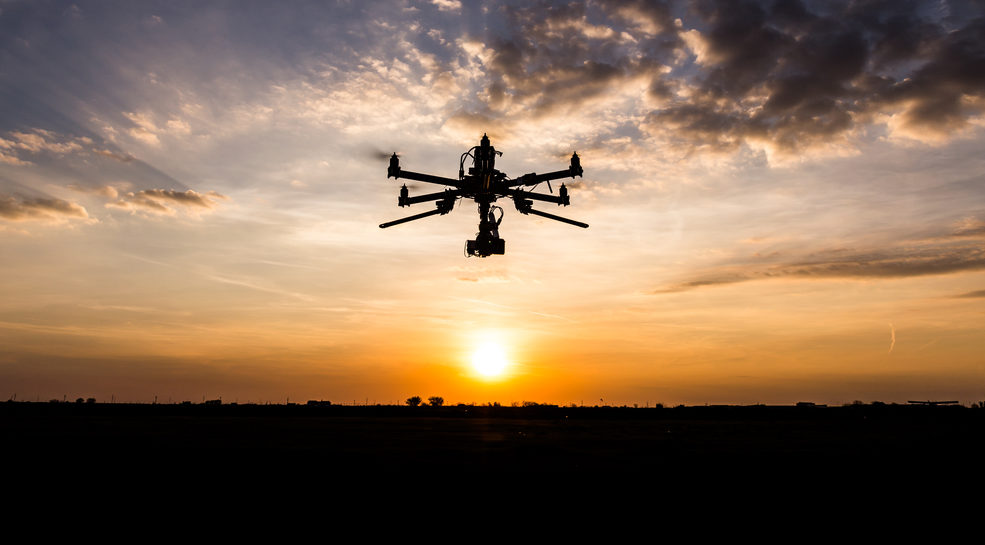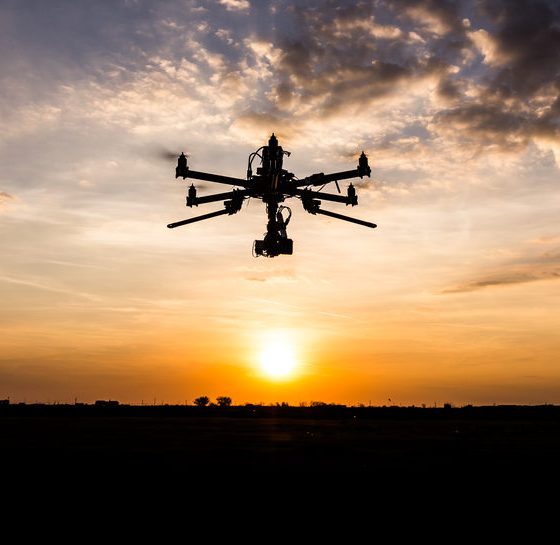

News
Wireless charging hotspots let drones fly forever through in-air recharges
A Portland, Oregon-based company named Global Energy Transmission (GET) is developing a network of wireless charging hotspots for drones. With only six minutes hovering over a grid for a full charge, an electric industrial class drone can repeat the cycle of charging and flying until its battery is drained without ever having to land or connect to a cable using this technology. GET’s long-term vision includes a cell-tower like infrastructure comprising numerous charging stations, enabling indefinite flying time for drones in the network. If successful, this technology could reinvent the commercial drone industry, providing 24/7 solutions in dedicated areas for things like deliveries, monitoring, and security.
Per GET’s website, the drone built for the charging network technology weighs about 18 lbs without the battery, can carry about 15 lbs, and can fly for 28 minutes weighing 30 lbs at takeoff. The maximum flying speed is around 37 mph, and servicing of the drone is recommended every 300-1000 flight hours. The maximum power transmitted during the charging stage is 12kW – it consumes 1550W while hovering.
Overall, the GET charging grid looks generally like a hexagonal frame raised onto poles with wires laced throughout. Spanning 26 feet across, the frame’s size is designed to enable multiple drones to charge simultaneously. A working prototype of the full system has already been showcased, and numerous videos are also available for anyone interested in more detail about the development team’s process. One such video lasts over two hours to demonstrate multiple battery-drains and in-air recharges on a continuous feed.

Drones are currently being used to provide numerous consumer solutions in a wide variety of markets. Along with video and photography, these small flying crafts are being utilized or developed for places like the construction industry for mapping and site monitoring, search and rescue missions, and even transporting organs between hospitals. Of course, the short life span of a drone battery – about 22 minutes in most cases – is well known to drone pilots, making the potential for a wireless charging network an innovative opportunity. According to William R. Kallman, GET’s US Director and partner from the Draper Network in a recent interview, their technology could also be scaled up to transfer 200 kW of power in the future, putting drone taxis within the realm of GET’s potential customer base.
GET announced its charging system at the AUVSI Xponential May 2018 show in Denver, Colorado and made an appearance at this year’s Consumer Electronics Show 2019 in Las Vegas. While the company is officially based in the US, there is also a branch office and engineering center in Moscow, Russia. Their executives, as well as most of its team, are originally from Moscow with backgrounds in physics and chemical engineering, among others.
The company is currently taking pre-orders for its GET Air™ solution which will include a wireless power charger, a 26-foot diameter charging area/grid, and two GET Air™ industrial class drones with pre-installed wireless charging systems. Expansions are also available, including an Autonomous Power Module for independent power supply to charging stations with limited or no access to electricity. Operational and maintenance support are included, all for a package price of $120,000.
Watch the below video to see the GET drone charging system in action with some further details by their CEO:

News
Tesla FSD fleet is nearing 7 billion total miles, including 2.5 billion city miles
As can be seen on Tesla’s official FSD webpage, vehicles equipped with the system have now navigated over 6.99 billion miles.

Tesla’s Full Self-Driving (Supervised) fleet is closing in on almost 7 billion total miles driven, as per data posted by the company on its official FSD webpage.
These figures hint at the massive scale of data fueling Tesla’s rapid FSD improvements, which have been quite notable as of late.
FSD mileage milestones
As can be seen on Tesla’s official FSD webpage, vehicles equipped with the system have now navigated over 6.99 billion miles. Tesla owner and avid FSD tester Whole Mars Catalog also shared a screenshot indicating that from the nearly 7 billion miles traveled by the FSD fleet, more than 2.5 billion miles were driven inside cities.
City miles are particularly valuable for complex urban scenarios like unprotected turns, pedestrian interactions, and traffic lights. This is also the difference-maker for FSD, as only complex solutions, such as Waymo’s self-driving taxis, operate similarly on inner-city streets. And even then, incidents such as the San Francisco blackouts have proven challenging for sensor-rich vehicles like Waymos.
Tesla’s data edge
Tesla has a number of advantages in the autonomous vehicle sector, one of which is the size of its fleet and the number of vehicles training FSD on real-world roads. Tesla’s nearly 7 billion FSD miles then allow the company to roll out updates that make its vehicles behave like they are being driven by experienced drivers, even if they are operating on their own.
So notable are Tesla’s improvements to FSD that NVIDIA Director of Robotics Jim Fan, after experiencing FSD v14, noted that the system is the first AI that passes what he described as a “Physical Turing Test.”
“Despite knowing exactly how robot learning works, I still find it magical watching the steering wheel turn by itself. First it feels surreal, next it becomes routine. Then, like the smartphone, taking it away actively hurts. This is how humanity gets rewired and glued to god-like technologies,” Fan wrote in a post on X.
News
Tesla starts showing how FSD will change lives in Europe
Local officials tested the system on narrow country roads and were impressed by FSD’s smooth, human-like driving, with some calling the service a game-changer for everyday life in areas that are far from urban centers.

Tesla has launched Europe’s first public shuttle service using Full Self-Driving (Supervised) in the rural Eifelkreis Bitburg-Prüm region of Germany, demonstrating how the technology can restore independence and mobility for people who struggle with limited transport options.
Local officials tested the system on narrow country roads and were impressed by FSD’s smooth, human-like driving, with some calling the service a game-changer for everyday life in areas that are far from urban centers.
Officials see real impact on rural residents
Arzfeld Mayor Johannes Kuhl and District Administrator Andreas Kruppert personally tested the Tesla shuttle service. This allowed them to see just how well FSD navigated winding lanes and rural roads confidently. Kruppert said, “Autonomous driving sounds like science fiction to many, but we simply see here that it works totally well in rural regions too.” Kuhl, for his part, also noted that FSD “feels like a very experienced driver.”
The pilot complements the area’s “Citizen Bus” program, which provides on-demand rides for elderly residents who can no longer drive themselves. Tesla Europe shared a video of a demonstration of the service, highlighting how FSD gives people their freedom back, even in places where public transport is not as prevalent.
What the Ministry for Economic Affairs and Transport says
Rhineland-Palatinate’s Minister Daniela Schmitt supported the project, praising the collaboration that made this “first of its kind in Europe” possible. As per the ministry, the rural rollout for the service shows FSD’s potential beyond major cities, and it delivers tangible benefits like grocery runs, doctor visits, and social connections for isolated residents.
“Reliable and flexible mobility is especially vital in rural areas. With the launch of a shuttle service using self-driving vehicles (FSD supervised) by Tesla in the Eifelkreis Bitburg-Prüm, an innovative pilot project is now getting underway that complements local community bus services. It is the first project of its kind in Europe.
“The result is a real gain for rural mobility: greater accessibility, more flexibility and tangible benefits for everyday life. A strong signal for innovation, cooperation and future-oriented mobility beyond urban centers,” the ministry wrote in a LinkedIn post.
News
Tesla China quietly posts Robotaxi-related job listing
Tesla China is currently seeking a Low Voltage Electrical Engineer to work on circuit board design for the company’s autonomous vehicles.

Tesla has posted a new job listing in Shanghai explicitly tied to its Robotaxi program, fueling speculation that the company is preparing to launch its dedicated autonomous ride-hailing service in China.
As noted in the listing, Tesla China is currently seeking a Low Voltage Electrical Engineer to work on circuit board design for the company’s autonomous vehicles.
Robotaxi-specific role
The listing, which was shared on social media platform X by industry watcher @tslaming, suggested that Tesla China is looking to fill the role urgently. The job listing itself specifically mentions that the person hired for the role will be working on the Low Voltage Hardware team, which would design the circuit boards that would serve as the nervous system of the Robotaxi.
Key tasks for the role, as indicated in the job listing, include collaboration with PCB layout, firmware, mechanical, program management, and validation teams, among other responsibilities. The role is based in Shanghai.
China Robotaxi launch
China represents a massive potential market for robotaxis, with its dense urban centers and supportive policies in select cities. Tesla has limited permission to roll out FSD in the country, though despite this, its vehicles have been hailed as among the best in the market when it comes to autonomous features. So far, at least, it appears that China supports Tesla’s FSD and Robotaxi rollout.
This was hinted at in November, when Tesla brought the Cybercab to the 8th China International Import Expo (CIIE) in Shanghai, marking the first time that the autonomous two-seater was brought to the Asia-Pacific region. The vehicle, despite not having a release date in China, received a significant amount of interest among the event’s attendees.








